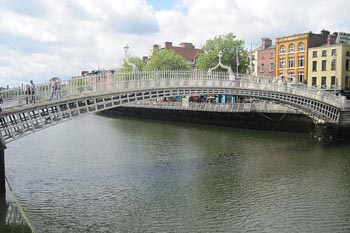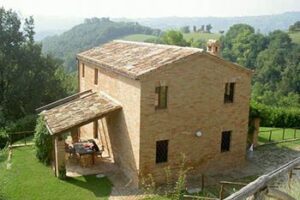
Kayaking and Culture in Le Marche, Italy
By Ann Banks
Just because I love to kayak does not mean I love remote, untrammeled Nature.
For the backdrop of my paddling trip, I wanted a domesticated terrain where humans had intervened – planting vineyards and olive groves, building castles and monasteries.
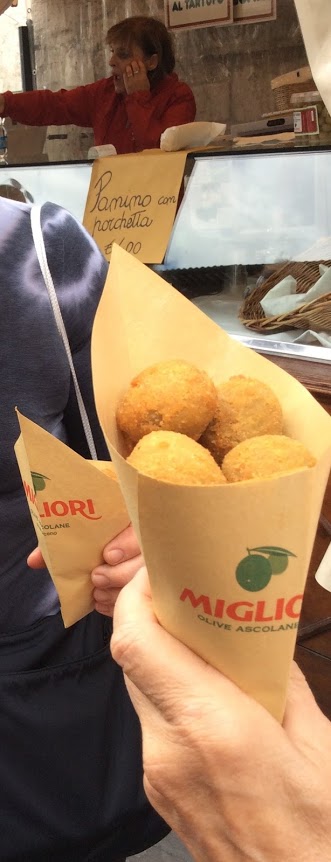
The answer, of course, lay in Italy (as so many answers do). I found my dream trip on the website of a kayak touring company called Tofino Expeditions. The company runs a number of tours to different parts of Italy.
All combined kayaking and culture and all looked irresistible. Le Marche, Italy’s least well-known province was a great choice.
I had found plenty of organized kayaking excursions before, but there was something wrong with all of them. Either the photos showed the dread “sit-atop” kayaks, standard equipment for resort day trippers, or . . . camping was involved. Those itineraries were in places where you knew insect repellant (percentage of DEET specified) would feature prominently in trip packing lists.
I wanted my kayaking with history, culture, and cuisine.
Across Three Provinces
I chose a kayaking trip that spanned three provinces of central Italy, each with a different landscape, history, and cuisine. Starting in the Le Marche, a region northeast of Rome near the Adriatic, our nine-day trip would take us westward across the Italian boot from the Adriatic to the Mediterranean.
We would kayak on both coasts; in the middle, we’d paddle for several days on Umbria’s enormous Lake Trasimeno, home to three islands and site of a famous battle during the second Punic war in which Hannibal massacred the Romans.
On our way across the historical heart of Italy, we would satisfy the cultural requirement of my dream itinerary by visiting the UNESCO World Heritage sites of Siena and Assisi, as well as a number of small Roman hill towns unknown to me. Nights would be spent in a series of rural agriturismos, where we would partake of Italian farm-to-table cuisine.
We and the kayaks would be ferried from one place to the next by comfortable air-conditioned van, with the guides doing all the heavy lifting.
First Guided Tour
Peter and I tend to be independent travelers and we had never signed up for a guided tour before. But we knew there was no way we could manage the logistics of such a trip on our own.
I wasn’t concerned about being stuck with incompatible fellow travelers since I figured the odds were good that such a trip would attract like-minded people. I was right.
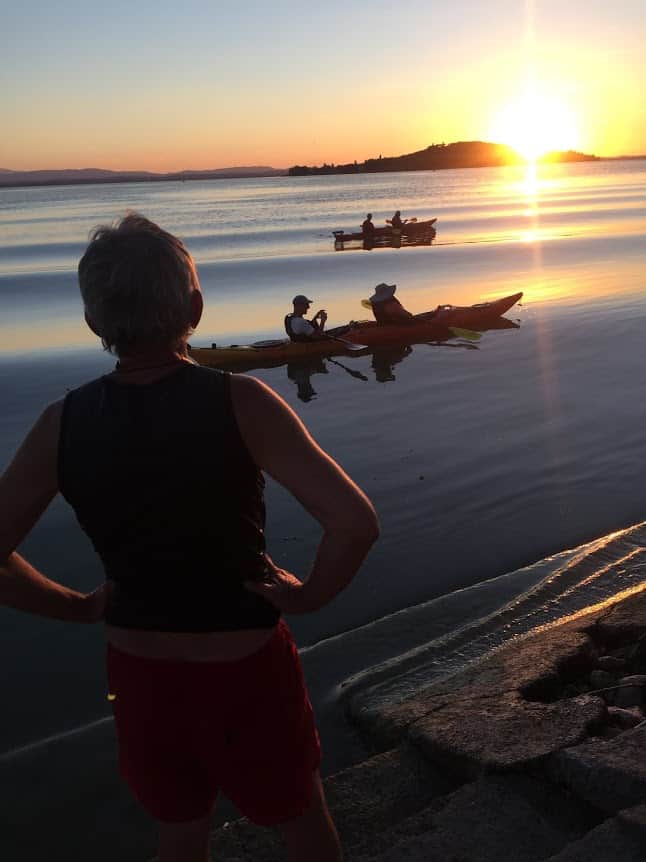
At dinner the first night we learned, encouragingly, that the two other couples were repeat Tofino customers. They had each been on several of the company’s Italy trips and had even traveled with our guide Marco before.
We were a geographically diverse bunch – Barbara and Joel were from Seattle; Alison and Larry from Minnesota, with Peter and I, the New Yorkers, representing the East Coast.
Everybody had a sense of humor, everybody loved Italian food, wine and gelato (a daily necessity), and we were all experienced recreational kayakers. Later in the trip, we discovered almost by accident that Larry’s skills were much more advanced than that. He was too modest to say so, but he was a regular on more challenging kayak expeditions, the kind I’d been so eager to avoid.
We were joined at dinner by our guide Marco (aka The Miracle Worker) and his Italian movie-star handsome assistant Enrico. We were eager for our first day of paddling, starting the next morning on the Riviera del Conero, a beautiful stretch of Adriatic coast where a mountain plunges directly into the sea forming secluded grottos and secret beaches accessible only by water.
It was not to happen – at least not on that day. We woke to the news that it was too windy for our paddling excursion and we would have to spend the day on land.
This was when Marco first demonstrated his magician skills at pulling rabbits out of hats. We were in his home territory; he was a son of Le Marche and he had no trouble improvising an itinerary for the day that quickly dispelled any disappointment we might have been feeling.
No Doubles Please
I love to kayak. Some years ago my husband and I bought a double kayak from friends who were getting divorced — though we soon traded it for a couple of singles. (They don’t call the two-seaters “divorce kayaks” for nothing.) Once we’d made that equipment exchange, I felt like I’d found my sport.
I loved the feeling of being out on the water and traveling from one place to another using my own muscle power. I loved that it is quiet – no motors involved. I loved gliding past the water side of scenes I knew only from the land.
A theme of Marco’s was that Le Marche, besides being less crowded than Tuscany, is at least its equal in pastoral landscapes and captivating ancient towns and villages. He took us first to Ascoli Piceno, a pre-Roman town bordered by two rivers. Its central piazza was “modernized” in the 15th century with travertine marble and is said to be one of the finest Renaissance squares in all Italy.

Soon we were sitting at a café table at the beautiful Art Noveau Caffe Meletti, with its pink colonnaded façade, drinking its famous coffee laced with anisette. None of us had ever heard of Ascoli before, including the old Italy hands who were our traveling companions. But there it was, waiting for us to discover it: the first of many rabbits Marco was to produce over the next eight days.
Before we left Ascoli, Marco also introduced us to a local specialty: fried green olives stuffed with ground veal. You buy them in paper cones from street vendors, and if they tasted better they would be the perfect snack for wandering around town. Nevertheless, they are famous all over Italy and even have their own Wikipedia entry.
The following morning we drove to a beach town on the Adriatic and met our kayaks. They turned out to be much better equipment than Peter and I had at home. They also turned out to be all double kayaks, as I had neglected to specify that Peter and I prefer singles. Wooden paddles and all!
Single or Double?
We ended up having a very harmonious paddle together — a good sign I thought, of the progress of our marriage. We assured Marco that we would be perfectly happy to continue the trip in one of the doubles but he insisted on returning to his house to pick up single kayaks for us.
I was a little worried that I would have trouble keeping up with the double kayakers if I was entirely under my own steam. Fortunately our next paddling site and aquatic home for the next few days was the beautiful and usually placid Lake Trasimeno on the border of Umbria and Tuscany.

The lake was a perfect dreamscape, surrounded by olive groves and tidy vineyards, overlooked by medieval villages and castles perched on hilltops. It was the ideal setting for the kind of languid, meditative paddling I often prefer – going nowhere in particular and going there very slowly.
In lake’s southeastern corner, towering thickets of reeds formed mazes that invited exploration, and at sunset we watched the sky darken with great flocks of migratory birds the area is known for.
It was at Trasimeno that Marco produced the second of his magic rabbits. We were scheduled to eat dinner at a restaurant on Isola Polvese, one of the islands in the middle of the lake and, as the moon was full, we intended to kayak over.
When a last-minute circumstance scuttled that plan, Marco got on his cell phone and called someone he knew in the area who called someone he knew. Within a few minutes, a fisherman showed up with his boat to ferry us to the island and what turned out to be a very romantic moonlit dinner.
Magicians generally don’t like to reveal the secret behind their tricks, but Marco was pretty forthcoming: research, research and more research. Exhaustive scouting by car, kayak, and bicycle.
Everything depends on local connections, says Marco – an adage he proved again and again. In our visit to Assisi, for example, he led us on a labyrinthine path through back streets to find a tiny gelato shop.
No Powdered Mix
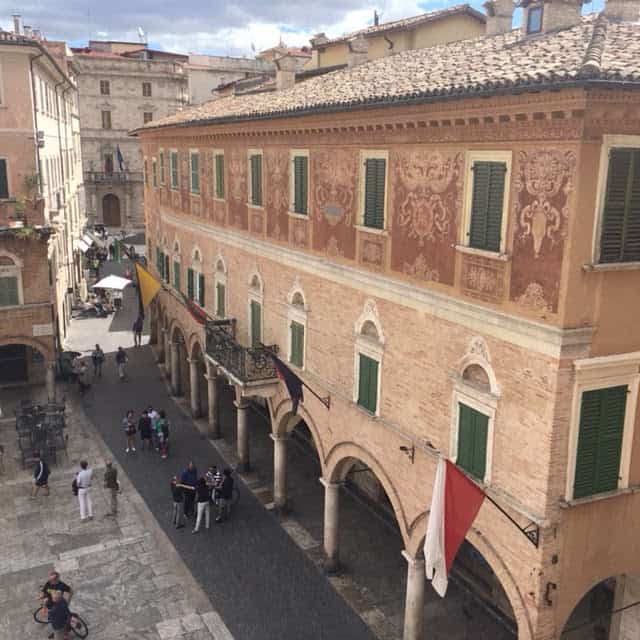
Never mind that on the way we passed any number of enticing gelato places with attractive signage. “They may advertise that they are artisanal but they use powdered mix,” he said shuddering. The only gelato that met his exacting standards was made exclusively with fresh fruit.
We benefitted every day from Marco’s genius at ferreting out “extras” for us to enjoy – Roman bath-style spas, special seafood restaurants, local olive oil and wine tastings. (Local, according to Marco, “could mean 10 kilometers or 30 –but not 200’) But this was meant to be a kayaking trip with culture thrown in, not the other way around.
And so it was, on the concluding portion of the journey. Our Italy traverse landed us in the rugged coastal region of western Tuscany known as the Maremma.
And here, in fairly windy conditions, I discovered that I had more to learn about kayaking than I had picked up from my lazy recreational practice. “Did you ever take a kayaking lesson?” Marco asked. “No,” I admitted, “but I watched a YouTube video.”

On the longest and windiest paddle of the trip , I came to regret my hubris in preferring a single kayak.
Humiliating Tow
I had trouble keeping up with the group and eventually had to accept the humiliation of being towed by Enrico.
Back on the beach, Marco gave me tips about paddle placement (farther forward) and powering your stroke with both arms.
These fine points of technique had not been covered in the YouTube video and instantly improved my performance.
The next day, our last on the water, the Tyrrhenian Sea was churned into gentle surf. Marco offered double kayak rides to anyone who wanted to try out kayak surfing.
I took him up on it and so have a video of myself plunging through the waves in the front seat of the kayak (with Marco paddling furiously in the back seat to keep us afloat).
There was nothing especially brave about it on my part, but I felt it almost redeemed me, in my own eyes at least, from the mortification of having been towed the day before.
- Venice on a Kayak - November 23, 2022
- Le Marche, A Great Place to Paddle - January 1, 2018
- Carriacou, Speaking Words of Shakespeare - May 29, 2016



